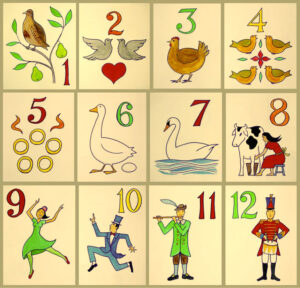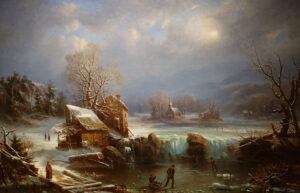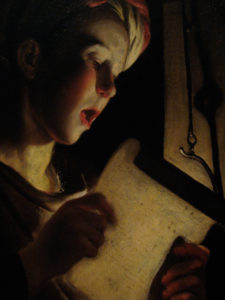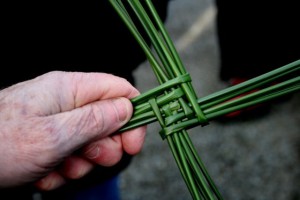My Aunt Mary, who was my dad’s older sister and who beamed love and light into the world wherever she walked, was also famous for often saying the words, “I feel so bad,” words that prefaced any number of things she felt badly about, even things completely out of her control. I feel so bad your car needs new tires. I feel so bad you’ve got a stomach bug. I feel so bad you didn’t have time to make Christmas cookies––here, I’ve made some for you.
I’ve been thinking about Aunt Mary because it is Christmas, when I think of all who have come and gone and left their mark on my world, but also because I feel so bad for not giving you this year a proper chapter on this Book of Days blog for the Twelve Days of Christmas. I was tired, I was a bit overwhelmed, and then Christmas Eve came, and that was beautiful, and then things went awry and here we are at the Second Day of Christmas now and my family has yet to have Christmas Dinner or open presents or any of the other things we typically do on Christmas Day. Mom landed in the ER that morning, and my sister and I spent Christmas Day on various park benches and picnic tables outside the ER. Breakfast that day wasn’t until about 3 in the afternoon, found at a local, rather shady Dunkin’ Donuts. The coffee was good but the egg sandwiches tasted faintly of Pinesol. Mom finally got to a room on Christmas Night, and my sister was able to visit her, but now the hospital is on lockdown again so no more visitors are allowed. The best news is that Mom is feeling better and she is much improved and we hope she’ll be home again in a few days. When she is home again, we will gather for a proper Christmas dinner and presents and Christmas Day, belated. Mom’s cousin in Milano, Romeo, tells us that in Italy, “Si dice che il Natale si festeggia quando uno vuole”––They say that Christmas is celebrated when one wants. We are taking the Italian approach this year. The important thing is Mom is fine and well and will be home soon. Who could ask for a better Christmas Day than that?
Meantime, let me give you the most basic of guidance for the traditions of these Twelve Days of Christmas that began yesterday with St. Stephan’s Day. I mentioned in my previous post that there are two ways of calculating these Twelve Days. The approach we follow is the one that places six days in the old year and six in the new. It is probably one day off from most church-oriented calculations, but I would argue it is a more traditional and older approach. If you’d like to follow along on this journey, we bid you most welcome. By all means, celebrate Christmas when you want. My joy is simply that you join us in marking the days and celebrating, in whatever way that means to you.
Here then, is my Convivio Quick Guide to the Twelve Days: Christmas Day, December 25, is a day outside ordinary time. It stands alone in its holiness, a holyday/holiday if ever there was one. December 26 brings the First Day of Christmas: it is St. Stephen’s Day, and Boxing Day. We typically make soup for St. Stephen’s Day, a pause for lighter fare after the rich feasts of Christmas Eve and Christmas Day (I am making my St. Stephen’s Day soup for tonight’s supper, a bit late again). The 26th also brings the start of a newer tradition, the First Day of Kwanzaa, which brings yet more light to the world through candles: each candle and each day, through the First of January, focusing on one of seven principles: first, umoja (unity); then kujichagulia (self-determination); next, ujima (collective work and responsibility); followed by ujamaa (cooperative economics); and then nia (purpose); kuumba (creativity); and finally imani (faith). The Second Day of Christmas, December 27, is St. John’s Day, and it is typically celebrated with wine. St. John the Evangelist was the only one of Christ’s disciples who did not meet a violent end for his beliefs. Several attempts were made on his life, though, the most famous of which involved poisoned wine, which had no effect on the man. And so his day is a good one for one of the loveliest drinks of the Yuletide season, mulled wine. Here’s our recipe:
M U L L E D W I N E
A bottle of good red wine
Mulling spices (a blend of cinnamon, cloves, allspice, orange peel)
Sugar
Pour a quantity (enough for as many people as you are serving) of good red wine into a stainless steel pot and set it on the stove over medium heat. Add about a teaspoon of mulling spices for each serving (we sell some wonderful mulling spices at the Convivio Bookworks website that are from the Sabbathday Lake Shaker Community in Maine… they call it Mulled Cider Mix but it’s just as good in wine). Add sugar: start with a teaspoon or two of sugar and add more to taste. We prefer a less-sweet mulled wine, and while you can always add more sugar, you can’t take it away once it’s in. So my recommendation is to add the sugar gradually, tasting as you go. Heat to allow the spicy flavors to infuse the wine, but do not allow to boil. Strain before serving in cups (not glasses).
The Third Day of Christmas on December 28 brings Childremas, or Holy Innocents’ Day. It marks a dark day in history but I prefer to mark it with celebrating children and the children we once were. Play with kids, read children’s books. In Spain and Latin America, it’s a day for practical jokes. December 29 brings the Fourth Day of Christmas and the Feast of Fools, so make it as goofy a day as you’d like. My favorite thing to do this day? Watch Christmas at Pee-Wee’s Playhouse: it’s brilliant! There are no particular traditions associated with the Fifth Day of Christmas on December 30, but we have long reserved it as one for honoring the old Boar’s Head Carol and for feasting (feasting being a common theme for all the Twelve Days)… and whatever we serve this night, whether it be something elaborate or something simple, we do it with great fanfare. December 31 is of course New Year’s Eve and this is the focus for the Sixth Day of Christmas, as we say farewell to the old year and usher in the new. The Seventh Day of Christmas brings New Year’s Day, and it is traditional to sing and toast the apple trees. The act is called wassailing and the drink is wassail, as well. Get outside, honor your favorite tree, apple or not, give it a toast. Here’s our Wassail recipe:
C O N V I V I O W A S S A I L
Pour the contents of two large bottles of beer or ale (about 4 pints) into a pot and place it on the stove to heat slowly. Add about a half cup sugar and a healthy dose of mulling spices. (If you don’t have mulling spices on hand, you can use cinnamon sticks and whole cloves… though the mulling spices lend a more complex flavor.) Add a half pint each of orange juice and pineapple juice, as well as the juice of a large lemon. Peel and slice two apples and place the apple slices into the pot, too. Heat the brew but don’t let it boil, then pour the heated wassail into a punchbowl to serve.
The Second of January brings the Eighth Day of Christmas, which is St. Macarius’s Day. Macarius was a dour old chap but in his younger days he operated a confectionary in Alexandria. Between that and the fact that his name is so close to two different delicious confections, it is a day some call St. Macaroon’s Day. It is known as a day to enjoy sweets. We celebrate St. Genevieve on the Third of January, the Ninth Day of Christmas. She is a patron saint of Paris, founder there in 475 of Saint-Denys de la Chapelle, which stands today as part of the Basilica of St. Denis. Another of the saints we celebrate this dark time of year that is associated with light, Genevieve’s was a light that never went out. It is said that even as the devil would attempt to interrupt her prayers by blowing out her candle, Genevieve had the power to relight it without use of flint nor fire. She just willed it to happen. Talk about a light bearer. This Ninth Day is one to celebrate with candles and is a very good day for Francophiles to be in their element. Perhaps your evening meal should be French. The Tenth Day of Christmas on January 4 has little going on, traditionally speaking. I think of it as a good day for reflection, and for preparation for Twelfth Night, which comes on the evening of January 5, the Eleventh Day of Christmas. This is traditionally a cracking good party, a proper send off for Yule and old Father Christmas. In the overnight hours, la Befana, one of the last of the midwinter gift bearers, will make her way through Italy on a broom bringing small presents to good children and delicious sweet coal to naughty ones––so it’s hard to choose which is better. We Italians like to keep things ambiguous. In Spain and Latin America, los Tres Reyes will be delivering presents. The stories of la Befana and los Tres Reyes are intertwined… the three kings stopped at la Befana’s on their way to visit the Christ child and invited her along, but she, like most Italian women I know, had far too much to do, so she declined their invitation, and then later had misgivings about that decision. Still to this day she searches for the child each Epiphany Eve.
January 6 brings Epiphany and the Twelfth Day of Christmas. This is traditionally seen as the day the Magi arrived at the stable to see the child and to bring gifts of frankincense, gold, and myrrh. Our tradition in this house is one we witnessed remnants of far and wide on our travels a few years back in Austria, Switzerland, and Germany: We gather together outside our front door, and all who are gathered take turns writing the elements of an inscription in chalk on the lintel above the door. The inscription is comprised of the initials of the Magi (C for Caspar, M for Melchior, B for Balthasar), blanketed on each side by the year, punctuated with crosses: this time around then, it will be 20+C+M+B+22. Each year, my silent prayer outside in the cold night air is that no one will be missing when we next gather to do this. With this, we find ourselves on the other side of the balanced bridge that brought us from one year to the next through the portal of Christmas.
May these Twelve Days bring only joy your way. I bid you this, and I bid you peace. Merry Christmas.
Image: Twelve Days of Christmas. Unknown artist, courtesy Wikimedia Commons.




